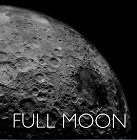
 Story: Photographer Michael Light delves into NASA’s archives and does what no one had done in the thirty years since the landing of Apollo 11 – gained access to the original master negatives and struck the first new copies of these iconic images from space since the missions were flown. The digitally scanned images offer a new degree of resolution to shots of the moon’s surface, the astronauts and their vehicles, and even their looks back at the Earth.
Story: Photographer Michael Light delves into NASA’s archives and does what no one had done in the thirty years since the landing of Apollo 11 – gained access to the original master negatives and struck the first new copies of these iconic images from space since the missions were flown. The digitally scanned images offer a new degree of resolution to shots of the moon’s surface, the astronauts and their vehicles, and even their looks back at the Earth.
Review: I don’t normally spend a lot of time reviewing art or photography books here, because what is there to say? That they’re pretty? One would presume that, or the book probably wouldn’t have made anyone’s publishing schedule. This book quickly grew on me, though. It’s not pretty. It’s mind-blowingly gorgeous.
We’ve gotten used to digital clarity with images from the Hubble Telescope and modern-day still and video cameras aboard the shuttle or the International Space Station, but some of the most valuable images that man’s push into space has yet produced have been relegated to copies of copies of copies. I don’t know who the book’s editor had to blackmail to scan the impossibly valuable original negatives, but it pays off in spades here – the inside flap’s boast of the sharpest images of space ever seen isn’t without merit.
Andrew Chaikin, author of “A Man On The Moon”, the definitive account of the Apollo program, provides a surprisingly detailed written chapter focusing on how the astronauts were trained to take pictures, what equipment was used, and how surprisingly unimportant NASA originally considered the very idea of taking pictures from space.
If there are any drawbacks to the book, it’s that not all of the images are from NASA’s still archives (some frames of motion picture film are included of the launch of a Saturn V, and the difference in quality between those shots and the digitally-scanned photos is quite noticeable), nor are the images exclusively from the Apollo program. Some Gemini images are included, though that can be excused conceptually at least – Gemini has become the “middle child” of the early space efforts. Neither as pioneering as Mercury or as exciting as Apollo, Gemini nevertheless gave the astronauts much-needed time to perfect techniques that we couldn’t have gone to the moon without. Light also fesses up to adding a blur effect to one photo in the book that wasn’t actually on the negative.
But these few gripes are more than balanced out by an incredible selection of photos, many of which haven’t been published before – as Chaikin’s chapter points out, there were thousands more images recorded than have ever been seen by the public. That gets a lot of points from me, but fear not, some of the most iconic images – the ones we’ve all seen – are also included, probably because Light realized that there’d be a lunar lynching party with his name on it if those pictures didn’t receive this digital remastering treatment.
If you like looking at the moon, give this book a try – and you may well find that the most arresting shots are those pointing back at the Earth.
Year: 1999
Authors: Michael Light, Andrew Chaikin
Publisher: Knopf
Pages: 236 pages